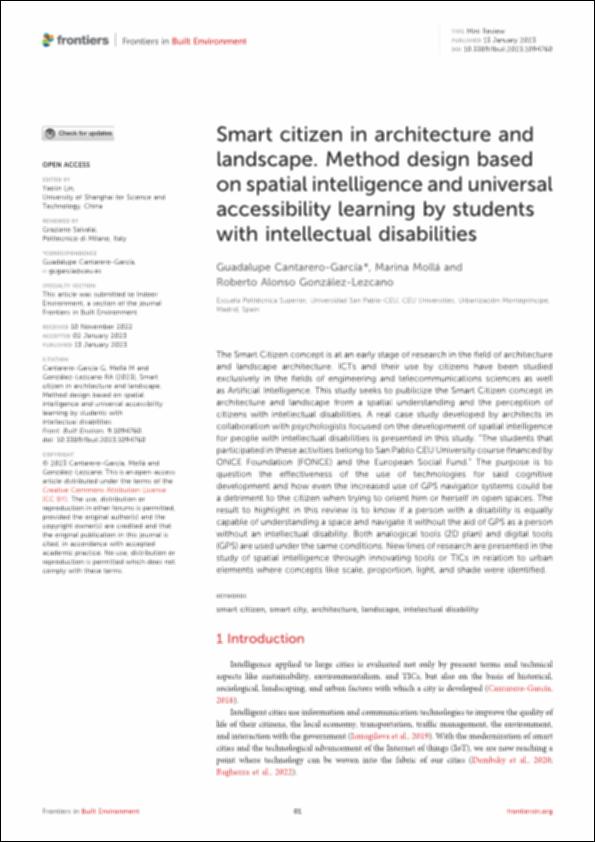Por favor, use este identificador para citar o enlazar este ítem:
http://hdl.handle.net/10637/14317Smart citizen in architecture and landscape: Method design based on spatial intelligence and universal accessibility learning by students with intellectual disabilities
| Título : | Smart citizen in architecture and landscape: Method design based on spatial intelligence and universal accessibility learning by students with intellectual disabilities |
| Autor : | Cantarero García, Guadalupe Mollá Ballesteros, Marina González Lezcano, Roberto Alonso. |
| Materias: | Smart citizen; Smart city; Architecture; Landscape; Intelectual disability |
| Editorial : | Frontiers Media |
| Citación : | Cantarero-García G, Mollá M and González-Lezcano RA (2023), Smart citizen in architecture and landscape. Method design based on spatial intelligence and universal accessibility learning by students with intellectual disabilities. Front. Built Environ. 9:1094760. doi: 10.3389/fbuil.2023.1094760 |
| Resumen : | The Smart Citizen concept is at an early stage of research in the field of architecture and landscape architecture. ICTs and their use by citizens have been studied exclusively in the fields of engineering and telecommunications sciences as well as Artificial Intelligence. This study seeks to publicize the Smart Citizen concept in architecture and landscape from a spatial understanding and the perception of citizens with intellectual disabilities. A real case study developed by architects in collaboration with psychologists focused on the development of spatial intelligence for people with intellectual disabilities is presented in this study. “The students that participated in these activities belong to San Pablo CEU University course financed by ONCE Foundation (FONCE) and the European Social Fund.” The purpose is to question the effectiveness of the use of technologies for said cognitive development and how even the increased use of GPS navigator systems could be a detriment to the citizen when trying to orient him or herself in open spaces. The result to highlight in this review is to know if a person with a disability is equally capable of understanding a space and navigate it without the aid of GPS as a person without an intellectual disability. Both analogical tools (2D plan) and digital tools (GPS) are used under the same conditions. New lines of research are presented in the study of spatial intelligence through innovating tools or TICs in relation to urban elements where concepts like scale, proportion, light, and shade were identified |
| URI : | http://hdl.handle.net/10637/14317 |
| Derechos: | http://creativecommons.org/licenses/by-nc-nd/4.0/deed.es |
| Fecha de publicación : | 13-ene-2023 |
| Centro : | Universidad San Pablo-CEU |
| Aparece en las colecciones: | Escuela de Politécnica Superior |
Los ítems de DSpace están protegidos por copyright, con todos los derechos reservados, a menos que se indique lo contrario.


